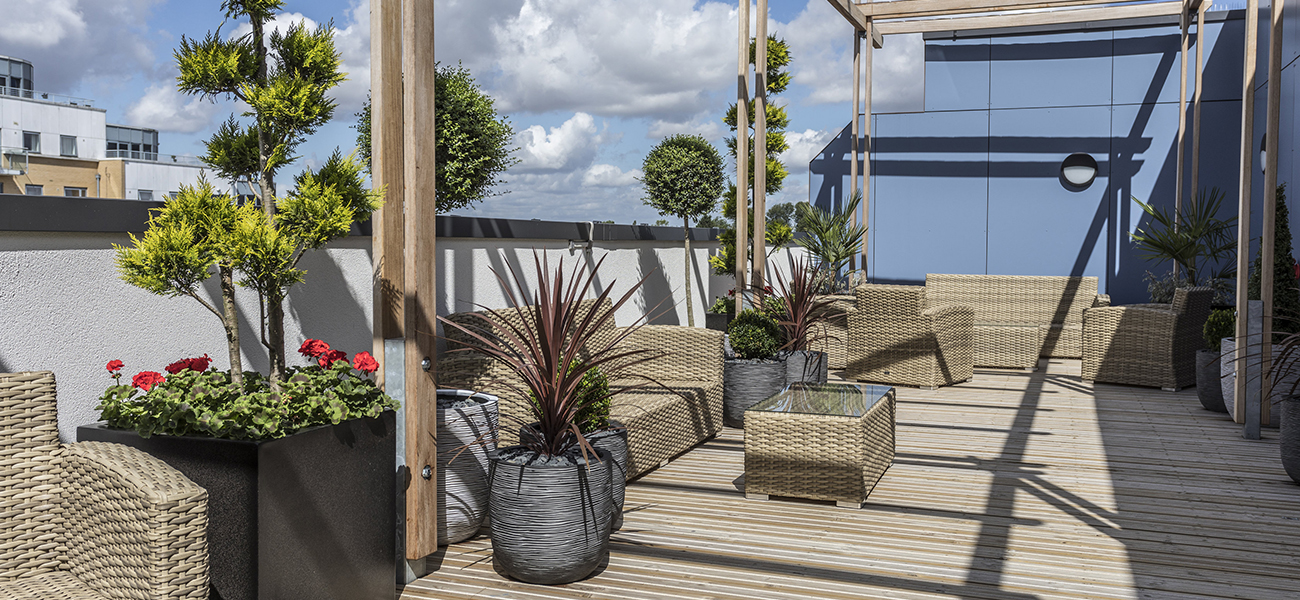Choosing the right type of deck boards

Timber decking is an increasingly popular surface used within many public spaces from walkways and bridal ways to bars and restaurants. But selecting the right type of decking depends on many different things; treatment, strength grade, profile, and slip risk. Below are some of the common considerations and how to make the right product choice.
Location, location, location
Where will the deck boards be used? Country rural applications have very different requirements to deck boards for urban environments. Waterways and wetlands suit castellated boards with a high level of antislip however, these boards can be difficult to walk on in urban footwear. For urban areas where consideration is required for pushchairs, wheelchairs high heeled shoes and trip risk with changes of level a smooth nonslip board is more suitable.
Play it safe…
Country rural = AntiSlip Plus® a castellated board with strips of coarse aggregate for the antislip strips (see slip risk for number of inserts).
Urban = CitiDeck® a smooth board with a less abrasive aggregate for antislip strips.
Slips and Trips
What level of slip resistance is required? Will standard deck boards without any non slip performance perform in application? It’s safe to say that any commercial decking project requires some slip resistance, but how do you get the optimum performance without paying for extra protection you may not need. If you install standard boards you run the risk of having to fit antislip protection retrospectively (which is never as effective) or replace the boards completely.
Play it safe…
Standard commercial slip risk = 2 antislip inserts.
High slip risk = 3 antislip inserts.
Treatment and Performance
Timber decking is preservative treated as standard but some applications require additional performance. For most applications Use Class 3 is ideal. This specification is for exterior use applications, out of ground contact. In marine environments, marinas or where there is likelihood of regular contact with water (even a hot tub would be included) it is recommended to specify Use Class 4, in ground contact.
It is also essential to check the other elements of the deck. Posts are invariably in ground contact and Use Class 4 is necessary. Care must be taken with joists, as from January 2020, the TDCA recommend that softwood deck joists or any timbers providing exterior structural support should be preservative pressure treated to Use Class 4 - regardless of whether they are in ground contact or not. This is to ensure the enhanced durability and safety of the deck substructure and is in line with the Wood Protection Association Code of Practice for Industrial Wood Preservation and BS 8417 which is to adopt this change in due course this year.
Where decking forms part of an exit, either a fire escape or main exit it should be treated with an exterior fire retardant. Although not classified as having preservative properties this process gives enhanced biological durability. Marley FTX Exterior Fire Retardant treated deck boards have a 30 year desired service life when used in Use Class 3 applications. (Exterior, out of ground contact).
Play it safe…
Above ground applications = Use Class 3. Ground/water contact = Use Class 4.
Decking as main walkway or exit = fire retardant treated.
Strength and Support
All timber decks, whether domestic or commercial, are designed to carry specific loads; these include both uniformly distributed and point loads. The grade rules for the use of structural timber are set out within BS 4978:2007+A1:2011 but how do you know which grade to use? C16 or C24?
Boards graded to C16 are generally recommended for most applications and if the correct spans are used this is usually the most cost effective option that will still meet the performance requirements. You should find our article explaining the difference between C16 and C24 helpful.
Most deck boards aren’t graded. Whilst failure is unlikely key areas such as deflection which consequently could cause a trip hazard (or even give the deck a ‘bouncy feel’) should be carefully considered. All recommended span tables are based on specific grades of timber.
Play it safe. Buy graded deck boards. Standard decks with small joist span = C16. Bridges, balconies and walkways with a wider joist span = C24.
Maintenance and Cleaning
Timber decks are a low maintenance solution, aside from an annual clean with a stiff broom they can be left to weather naturally. However some applications, such as decking in food service or hospitality areas require further consideration. How easy will it be to clean food and debris from the grooves in castellated decking. Could trapped debris make the deck a slip risk? It’s important to make sure that decking that will require regular cleaning is appropriate. Use a smooth board and then choose the relevant anti-slip solution (often CitiDeck® with a combination of smooth low and less abrasive grit.)
Play it safe…
Food service, event and hospitality areas = CitiDeck® a smooth board with a less abrasive aggregate for antislip strips
To find out more about Marley Decking solutions, contact your local specialist here.
Category: Decking Sustainability Timber